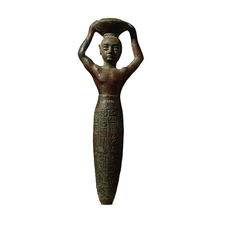
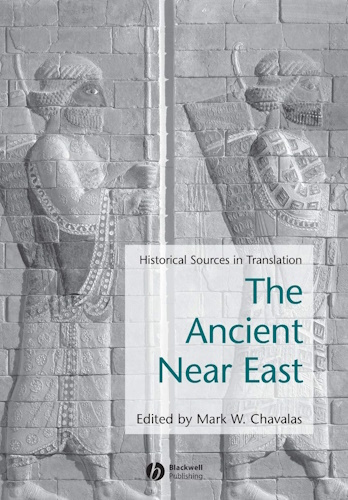

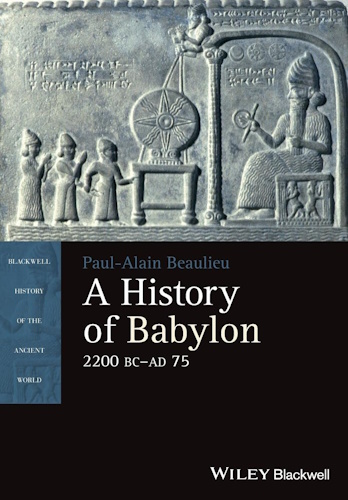

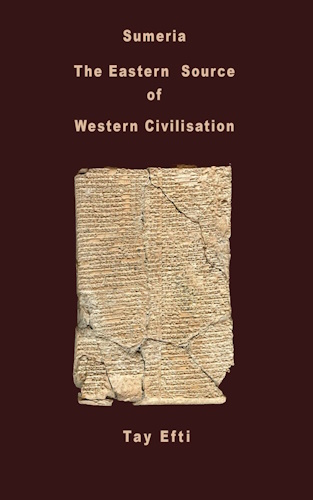



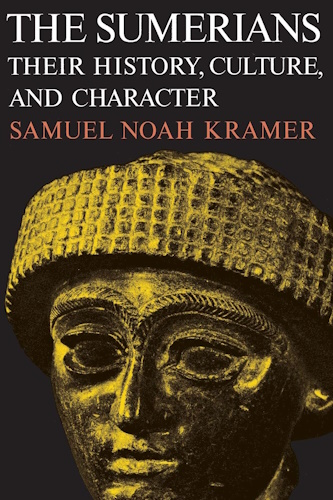

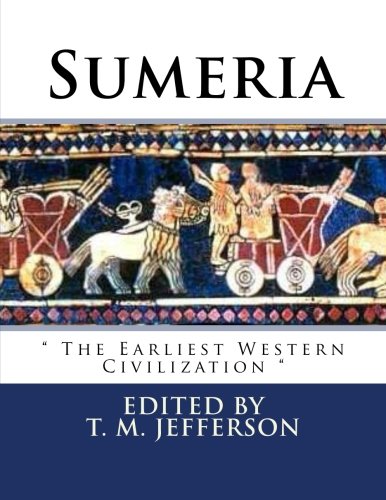

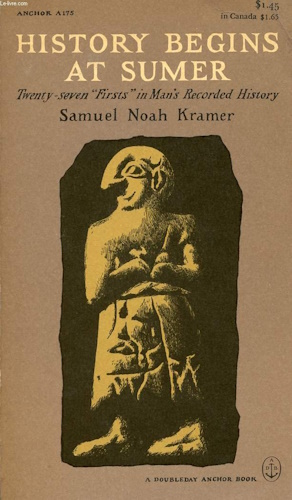

Anu
Supreme Monarch
of the
Mesopotamian Gods
ANU
Real Name: Anu
Occupation: Supreme Monarch of the Mesopotamian Gods, God of sky and heaven, former king of Sumer
Legal Status: Citizen of Celestial Dilmun
Identity: The general populace of Earth is unaware of Anu’s existence except as a mythological character.
Other Aliases: An (alternate spelling), Anus (Hittite name), Baal-Anu (Assyrian Name), Jabru (Elamite Name)
Place of Birth: Unknown, possibly Ur (now modern Tell al-Mugayyar, Iraq)
Marital Status: Married
Known Relatives: Anshar (father, alias An, possibly deceased), Kishar (mother, alias Ki), Ea (brother, alias Oannes), Mami, Damkina (sisters), Eriskegal (presumed sister), Dione (wife, alias Asherah), Aphrodite (adopted daughter, alias Inanna), Enlil, Hadad, Ninurta, Martu (sons by Asherah), Ningal, Nusku, Nergal, Gibil, Kinyras (sons by Mami), Zarpandit (daughter by Mami), Asnan, Ninlil, Gatumdug (daughters by Uras), Ithm, Sheger (sons by Uras), The Sebettu (sons by Aura), Shamash, Nanna, Ullikummis, Mot, Shachar, Shalim, (grandsons), Hammon, Pothos, Ninazu (uncles), Alalu (uncle, deceased), Wurusema, Omichle, Enmesarra, Derceto (aunts), Lakhmu (grandfather), Lakhamu (grandmother), Tiamat (great-grandmother, deceased), Apsu (great-grandfather, deceased),
Group Affiliations: The Anunnaki (Gods of Mesopotamia)
Base of Operations: Celestial Dilmun, formerly Ur, Sumer (now part of modern Iraq)
First Appearance: (behind the scenes) Thor #301
History: Anu is the eldest son of the Elder Gods Anshar, god of sky, and Kishar, goddess of earth. Anshar and Kishar were the grand-children of the great sea-goddess Tiamat. Often taking the form of a great dragon, Tiamat was the ultimate power of the ocean who had coupled with the freshwater god Apsu and gave birth to a lethal progeny of creatures who ravaged the earth and terrified ancient mortals. (Tiamat might be an ancient name for the primeval earth-goddess, Gaea, but this is unconfirmed).
Among her children was the ancient god Alalu who Anu overthrew as ruler of Ancient Sumeria by fatally wounding him. Anu usurped his role as ruler of the gods as his brother Ea fought Apsu, Tiamat’s lover, for control of the seas of earth. Anu and Ea split portions of Earth between them with their sister Eriskegal ruling the underworld (Some references call Eriskegal a daughter of Anu rather than his sister.) Anu had numerous children who were worshipped as gods by the Sumerian people. Among them were the four storm-gods, Enlil, Hadad, Ninurta and Martu, his sons by the exiled Titaness Dione who he had accepted as his wife. He adopted her daughter, Aphrodite, as the goddess Inanna without any knowledge of her parentage, or perhaps to irk Zeus, Ruler of the Olympian gods, with whom the Gods of Mesopotamia had been warring with for years.
Sometime in the 25th Millennium BC, Anu eventually noticed that mortals were becoming lazy and corrupt and were allowing the temples of the gods to be neglected. Some of the gods tried to dissuade his decision, but he proceeded to destroy them all by a flood and sent Enlil to inflict earth with a deluge of rain to cover the world. Ea, meanwhile, had located an honorable man named Utnapistim and his wife Ziusudra and instructed them on how to survive the flood by creating an ark to ride it out. Utnapishtim loaded his family and all the clean animals into the ark to survive. After seven days of torrential rain, much of the known world of the Sumerian Empire had become flooded. Utnapishtim and his family eventually landed safely upon the top of Mount Nisir (now known as modern Ararat). As the waters receded, he made a sacrifice to the sun god Shamash. Now realizing the rashness of his decision, Anu allowed Utnapishtim to live on earth and allowed Enlil to bestow on him immortality. Utnapishtim and his family started repopulating the earth with new respect to the gods.
Inanna, meanwhile, fell in love with Dumuzi, the grain god, but Eriskegal, Queen of the underworld, for reasons of her own, kidnapped the handsome god. Inanna went down to the underworld to retrieve him, but Eriskegal disgraced her by having her leave an article of clothing at each of then ten gates of the underworld. By time Inanna entered Eriskegal’s court, she was completely naked and vulnerable to be taken prisoner. Anu sent Enlil to free her and Enlil found her by ripping the gates asunder from the underworld. Inanna was returned to earth, but Dumuzi had to stay behind. Anu, however, arbitrated that Inanna and Dumuzi could share six months out of the year on earth to be together.
At some point, Adapa, the mortal son of Ea and ruler of Eridu, was displeased by the storm-god Ninurta because he had sent the south wind to turn over his royal boat. He shot an arrow into the sky that injured Ninurta and Ninurta revealed his injury to Anu. Angered, Anu wanted to kill the disrespectful king, but Ea brought Adapa to him to him to avoid any bloody consequences. Anu meanwhile decided on other means to get justice on his injured son. As Adapa arrived, he offered him some of the food of the gods out of courtesy. Suspecting it to be the food of the dead, Adapa refused. Anu then revealed to the mortal king that he had refused the food of the gods and because of it now all mortals would have to suffer eventual old age and death.
Anu, however, was soon overthrown by his son Enlil, as king of the gods and ruler of Sumeria. Anu cursed him to have three miserable sons for his disobedience and escaped to the sky where he separated the heavens and the earth. Anu welcomed most of the gods into this new realm he called Celestial Dilmun, but Enlil, now calling himself Dagon, was soon overthrown by his brother Hadad, now called Baal. He confined both of them to Earth and after both of them were ousted as rulers, he confined both of them to separate kingdoms in the underworld. From the heavens, Anu reclaimed his role as King of the gods.
Tiamat by now was slain by the god Marduk working in tandem with his father, Ea and Anu, Ruler of the Mesopotamian Gods. He became ruler of the earth under the now ascendant Babylonian Empire by replacing Baal-Hadad. Anu and Ea together split Tiamat’s corpse in half and used it to permanently bind the separation of heaven and earth. (In later myth, they created heaven and earth from her remains)
The Babylonian Empire was soon replaced by the Assyrian Empire who revered the war-god Nergal as their patron deity in his role as Assur. They never accomplished the power of the previous Sumerian or Babylonian Empires and were constantly trying to hold their power against invading tribes and by the Phoenicians from the west who worshipped many of the same gods under different names. The conflict in interest over their worshippers divided the interest of many of the Mesopotamian gods. Anu also realized that there was unrest from the growing Judaism Religion, which erroneously accused many of the former Sumerian gods as unholy gods or demons. With this amount of concern and interior unrest amongst the gods, Anu was unprepared for the power of the Olympian gods from Greece entering Phoenicia. The god Zeus in particular fell in love with the Phoenician princess Europa and spirited her off to Crete where she gave birth to the god-king Minos who founded the Minoan Civilization. Anu was finally able to route the interest of the Mesopotamian gods in the direction of the invading Olympian Gods as they both fought to withhold their perspective worship rites and establish boundaries on earth that they could claim. Asherah drawn out of loyalty to both the perspective pantheons arbitrated the peace between Zeus and Anu and eventually came to a truce. Part of the truce was that Zeus could retrieve Inanna, formerly Aphrodite, and bestow upon his daughter her true birthright as an Olympian Goddess. The Olympians promised to stay out of lands that the Greeks invaded and the Annunaki pledged to not interfere in the affairs of the Greeks.
The worship of the Annunaki meanwhile continued to wane, however, under Judaism and the now developing Christian religion. Anu began to believe he had been cheated in the deal with Zeus and Zeus started to feel an uprising from the Annunaki. As tension became unbearable and another war between the gods came close, Zeus found a way out. The Romans started slaughtering Christians in the names of the gods of Olympus. Dissatisfied with the bloodshed, he ordered the Olympian gods to break off ties with earth completely and cease interest in worship rites. The edict came to a surprise to Anu even as Zeus in a humble position presented the dilemma to Anu and proposed the same fate to his pantheon. The pact cemented their truce even as gods like Ares, Dagon, Apollo and others refused to cooperate. In 1000 AD, the Celestials returned to Earth. Long having an interest in human beings and their development, they ordered all the gods to stop trafficking completely with mortals. Their warning cemented the non-interference rule that Zeus and Anu had began and even spread it across the other pantheons of Earth. With the heads of the other pantheons of Earth that were or had been worshipped by mortals of Earth, Anu, Zeus and the other godheads discussed the potential threat the Celestials posed to Earth.
Arbitrating on behalf of Anu, Zeus met with Odin of the Asgardian Gods and Vishnu of the Hindu Gods and they went to confront the Third Host of the Celestials on behalf of all the gods of Earth. However, Odin and Zeus were pledged not to interfere with the Celestials when the Celestials threatened to seal off the inter-dimensional portals connecting the god’s dimensions to Earth. As a result of this pledge, the Annunaki had to lessen their contact with Earth although a few of them such as Ninurta and Shamash have masqueraded as mortals and spent time living with the human beings on Earth.
Odin, meanwhile, had withdrawn all the life forces of the Asgardians except that of his son Thor into the Destroyer created to oppose the Celestials. Odin’s spirit then entered the Destroyer and animated it into doing battle with the Fourth Host. They annihilated the Destroyer, but judged in favor of humanity’s favor when Gaea presented them with twelve genetically advanced human beings, the “Young Gods.” Thor meanwhile contracted Anu as per his pact with Odin and Anu bestowed upon him a fragment of the life forces required to restore the Asgardians to life after the destruction of the Destroyer.
In recent years, both Ninurta and Shamash have become renowned to the modern citizens of Iraq as superheroes. The modern-day descendants of their former worshippers do not actually believe them to be the actual gods of myth, but merely super-powered individuals paying homage to ancient myths. Considering the political turmoil in the area today, Ninurta has attempted to obtain from his father help in trying to bestow peace to the region and restore it to the glory seen in the past. Anu has had no part in these requests because in his mind it is the responsibility of mortal man to solve their own problems and find answers for the destruction that mankind has created.
Height: 6’2”
Weight: 445 lbs.
Eyes: Blue
Hair: White (Black in his youth)
Strength Level: Anu possesses superhuman strength enabling him to lift (press) almost 75 tons under optimal conditions.
Known Superhuman Powers: Anu possesses the conventional physical attributes of the Mesopotamian Gods. Like all of the Mesopotamian Gods, he is immortal. He has not aged since reaching adulthood and cannot die by any known conventional means. He is immune to all known terrestrial diseases and is invulnerable to conventional injury. If wounded, his godly life force would enable him to recover with superhuman speed. It would take an injury of such magnitude that it dispersed a major portion of his bodily molecules to cause him a physical death. Even then, it might be possible for Zeus, Odin, Ea or a number of gods of equal power working together to revive him. Anu does have some superhuman strength and his own godly metabolism gives him far greater than human endurance in all physical activities.
Anu possesses vast powers of an unknown nature, which seem to surpass the powers of any other Mesopotamian god. Magical in their form and nature, these powers can be employed in numerous forms. He can project rays of mystical forms resembling modern lasers that can explode on impact and erect shields and objects such as thrones and ships from this energy. He can also create dimensional portals at will to travel between earth and heaven and create spells that augment or enforce spells already in existence. He can project his image, voice or energy bolts from heaven to earth and even place bondage spells powerful enough of bonding individuals to certain realms. Anu seems to have limited precognitive and sensory awareness to perceive facts and information from beyond time and space.
Abilities: Anu is a shrewd and wily ruler as well as a just and beneficent deity.
Clarifications: Anu is not to be confused with:
Anu (Aine), Celtic goddess of earth
Danu, Celtic name of Gaea
MARDUK
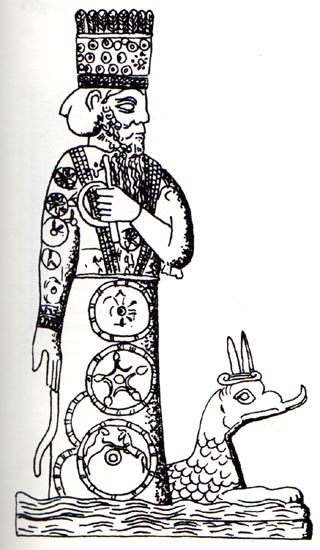
This is Marduk with Tiamat
MARDUK IS ANOTHER NAME FOR NIBIRU!
Alternatively, Tethys may simply mean "old woman"; certainly it bears some similarity to ἡ τήθη, meaning " grandmother," and she is often portrayed as being extremely ancient (cf. Callimachus, Iamb 4.52, fr. 194). Of the power exercised by Tethys, one myth relates that the prominent goddess of the Olympians, Hera, was not pleased with the placement of Callisto and Arcas in the sky, as the constellations Ursa Major and Ursa Minor, so she asked her nurse, Tethys, to help. Tethys, a marine goddess, caused the constellations forever to circle the sky and never drop below the horizon, hence explaining why they are circumpolar. Robert Graves interprets the use of the term nurse in Classical myths as identifying deities who once were goddesses of central importance in the periods before historical documentation
Marduk [mär'dook] (Sumerian spelling in Akkadian AMAR.UTU "solar calf"; Biblical Merodach) was the name of a late generation god from ancient Mesopotamia and patron deity of the city of Babylon, who, when Babylon permanently became the political center of the Euphrates valley in the time of Hammurabi (18th century BC), started to slowly rise to the position of the head of the Babylonian pantheon, position he fully acquired by the second half of the second millennium BCE.
Marduk's original character is obscure, but whatever special traits Marduk may have had were overshadowed by the reflex of the political development through which the Euphrates valley passed and which led to imbuing him with traits belonging to gods who at an earlier period were recognized as the heads of the pantheon.
There are more particularly two gods - Ea and Enlil - whose powers and attributes pass over to Marduk. In the case of Ea the transfer proceeds pacifically and without involving the effacement of the older god. Marduk is viewed as the son of Ea. The father voluntarily recognizes the superiority of the son and hands over to him the control of humanity. This association of Marduk and Ea, while indicating primarily the passing of the supremacy once enjoyed by Eridu to Babylon as a religious and political centre, may also reflect an early dependence of Babylon upon Eridu, not necessarily of a political character but, in view of the spread of culture in the Euphrates valley from the south to the north, the recognition of Eridu as the older centre on the part of the younger one.
While the relationship between Ea and Marduk is thus marked by harmony and an amicable abdication on the part of the father in favour of his son, Marduk's absorption of the power and prerogatives of Enlil of Nippur was at the expense of the latter's prestige. After the days of Hammurabi, the cult of Marduk eclipses that of Enlil, and although during the four centuries of Kassite control in Babylonia (c. 1570 BC1157 BC), Nippur and the cult of Enlil enjoyed a period of renaissance, when the reaction ensued it marked the definite and permanent triumph of Marduk over Enlil until the end of the Babylonian empire. The only serious rival to Marduk after ca. 1000 BC is Anshar in Assyria. In the south Marduk reigns supreme. He is normally referred to as Bel "Lord".
When Babylon became the capital of Mesopotamia, the patron deity of Babylon was elevated to the level of supreme god. In order to explain how Marduk seized power, Enûma Elish was written, which tells the story of Marduk's birth, heroic deeds, and becoming the ruler of the gods. This can be viewed as a form of Mesopotamian apologetics.
In Enûma Elish, a civil war between the gods was growing to a climatic battle. The Anunnaki gods gathered together to find one god who could defeat the gods rising against them. Marduk, a very young god, answered the call, and was promised the position of head god.When he killed his enemy he "wrested from him the Tablets of Destiny, wrongfully his" and assumed his new position. Under his reign humans were created to bear the burdens of life so the gods could be at leisure.
People were named after Marduk. For example, the Biblical personality Mordechai (Book of Esther) used this Gentile name in replacement of his Hebrew name Bilshan.Babylonian texts talk of the creation of Eridu by the god Marduk as the first city, 'the holy city, the dwelling of their [the other gods] delight'.
Nabu, god of wisdom, is a son of Marduk.
Etemenanki, "The temple of the creation of heaven and earth", was the name of a ziggurat to Marduk in the city of Babylon of the 6th century BC Chaldean (Neo-Babylonian) dynasty. Originally seven stories in height, little remains of it now save ruins. Etemenanki was later popularly identified with the Tower of Babel.
NAMMU - NAMMA ANTU
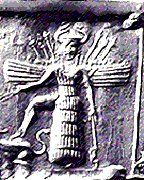
In Sumerian mythology, Nammu (more properly Namma) is the Sumerian creation goddess. If the Babylonian creation myth Enûma Elish is based on a Sumerian myth, which seems likely, Nammu/Namma is the Sumerian goddess of the primeval sea that gave birth to heaven and earth and the first gods. She was probably the first personification of the constellation which the Babylonians later called Tiamat and the Greeks called Cetus and represented the Apsu, the fresh water ocean which the Sumerians believed lay beneath the earth, the source of life-giving water and fertility in a country with almost no rainfall.
As Nammu/Namma is the goddess of the fertile waters, An is the god of the sky. Nammu/Namma and her son Enki created mankind as assistants for the gods. Enki is the god of human culture who also presides over the Absu. A winged goddess wearing a multi-horned crown stands with her head in the realm of the deities and their devotees. Her bird-clawed feet rest in a place, likely the underworld, inhabited by strange and demonic creatures. This shows the duality of her nature - as well as our own - above and below. Some think her to be Lilith, but the crown shows her to be a great goddess, almost certainly Inanna. Mesopotamian cylinder seal. Hematite. 2000-1600 BCE.
She was said to descend from the ancient family of the creator goddess Nammu, who was her grandmother. Inanna held "full power of judgment and decision and the control of the law of heaven and earth." Her sacred planet was Venus, the evening star. She was often symbolized as a lioness in battle. Along the Tigris and Euphrates rivers were many shrines and temples dedicated to Inanna.
The temple of E Anna, Inanna's House of Heaven, in Uruk, was the greatest of these. This temple was 5000 years old and had been built and rebuilt many times to hold a community of sacred women who cared for the temple lands. The high priestess of Inanna would choose for her bed one she would appoint as shepherd. He would represent Dumuzi, sacred son/lover of Inanna, if he could prove his worth.
In later times, Inanna's lost some of her attributes, which were then said then to have been given her by Enki, rather than by her grandmother Nammu and her mother Ningal.
The myth states that Inanna traveled to Eridu and was given the one hundred Mes, which were the gifts of culture such as truth and justice, as well as practical skills such as weaving and pottery-making. Though Enki regretted his drunken decision to release the Mes to her and sent mighty sea monsters to stop her boat as it sailed the Euphrates, she was able to defeat them and bring the knowledge back to Uruk.
Inanna was one of the most revered of goddesses among later Sumerian mythology. She was said to descend from the ancient family of the creator goddess Nammu, who was her grandmother. Inanna held "full power of judgment and decision and the control of the law of heaven and earth." Her sacred planet was Venus, the evening star. ...more on Wikipedia about "Inanna"
In Sumerian mythology, Nammu (more properly Namma **) is the Sumerian creation goddess. If the Babylonian creation myth Enûma Elish is based on a Sumerian myth, which seems likely, Nammu/Namma is the Sumerian goddess of the primeval sea that gave birth to heaven and earth and the first gods. She was probably the first personification of the constellation which the Babylonians later called Tiamat and the Greeks called Cetus and represented the Apsu, the fresh water ocean which the Sumerians believed lay beneath the earth, the source of life-giving water and fertility in a country with almost no rainfall. ...more on Wikipedia about "Nammu"
In Sumerian mythology, Ninhursag (or Ki) was the earth and mother- goddess she usually appears as the sister of Enlil. ...more on Wikipedia about "Ninhursag"
Ninlil, first called Sud, is the daughter of Nammu and An in Sumerian mythology. She lived in Dilmun with her family. Raped by her brother and future husband Enlil, she conceived a boy, Nanna, the future moon god. After her death, she became the goddess of the air, like Enlil. ...more on Wikipedia about "Ninlil"
Everybody should like www.shortopedia.com
In Babylonian mythology, Sarpanit (alternately Zarpanit, Zarpandit, Zerpanitum, Zerbanitu, or Zirbanit) is a mother goddess and the consort of the chief god, Marduk. She was worshipped via the rising moon, and was often depicted as being pregnant. She may be the same as Gamsu, Ishtar, and/or Beltis. ...more on Wikipedia about "Sarpanit"
Tiamat is a primeval monster/ goddess in Babylonian and Sumerian mythology, and a central figure in the Enûma Elish creation epic. John C. L. Gibson, in the Ugaritic glossary of Canaanite Myths and Legends, notes that "tehom" appears in the Ugaritic texts, c. 1400–1200 BCE, simply meaning the "sea". Such a depersonalized Tiamat (the -at ending makes her feminine) is "The Deep" (Hebrew tehom), present at the beginning of the book of Genesis. ...more on Wikipedia about "Tiamat"
The king as a temple builder with a basket of earth to make bricks
This bronze figure represents Ur-Nammu, the ruler of Ur (about 2112-2095 BC). It was made for burial in the foundations of a temple of Uruk. It was one of the duties of a Mesopotamian king to care for the gods and restore or rebuild their temples. In the late third millennium BC, rulers in southern Mesopotamia depicted themselves carrying out this pious task. Ur-Nammu lifts up a large basket of earth for making bricks. The copper 'peg' acted as a record for posterity and to receive the god's blessing.
The cuneiform inscription around and over the king's body states that Ur-Nammu dedicated the figure to Inana (Ishtar), the patron deity of Uruk. It also records the restoration of her temple called Eanna 'the house of heaven'. Her name appears to mean 'the lady of heaven'. She was associated with the goddess Ishtar and the planet known to us as Venus.
Towards the end of the third millennium BC, southern Mesopotamia was united under the control of the city of Ur. Ur-Nammu founded the empire, which stretched into Iran. He was a prodigious builder. The most impressive monuments of his reign were ziggurats which he constructed at various cities. Although not unlike the stepped pyramids of Egypt in appearance, ziggurats were made of solid brickwork and did not have tombs inside.
J.E. Reade, Mesopotamia (London, The British Museum Press, 1991)
H.W.F. Saggs, Babylonians (London, The British Museum Press, 1995)
E.D. Van Buren, Foundation offerings and figur (Berlin, H. Schoetz & Co., 1931)
Descendants of
The AN.UNNA.KI
Generation No. 3
ANU was the god by whose grace, kingship (aka Anutu, or 'Anu'-ship) flowed to earthly kings. ANU is often believed to have been the original principle, the 'god', of nature. He was once the universe in the form of both the upper and lower regions; and then he was divided in two, the upper region (i.e. heaven) remaining ANU and the lower region (i.e. earth) becoming his 'sister' / consort, ANATU. ANU bore children by both of his sisters, ANTU and KI, and by NIMUL, who was neither an official spouse or a half-sister (and for that reason, the firstborn son was destined not to be the rightful heir).
It should be noted that some scholars have stated that ANU, EN.KI and EN.LIL were siblings, rather than parent and sons, forming the "Creator Triad".
Child of ANU and NIMUL is:
A. E.A. / EN.KI4.
Children of ANU and KI or ANTU are:
B. NIN.HUR.SAG.
C. EN.LIL.
Other Children of ANU and ANTU (or by various consorts) are:
D. HEA.
E. LUGAL-EDIN.
F. LATARAK.
G. AB.GULA.
H. KU.SU.
I. RAM.MAN.
J. GI.BIL.
K. ISTAR.
1D2. ANTU3 (ANSHAR2, APSU1) {aka Nammu, Anatu, Antum, The Lady Of The Sky, The Primeval Sea} ANTU gave birth to the heaven and earth, according to some traditions. But the Babylonian traditions maintain that ANTU was formed out of ANU. ANTU is believed by some scholars as being simply the female form of ANU, and as such is simply the opposite of ANU. In her association with the Primeval Sea, ANTU is sometimes compared to Istar or Venus; she is sometimes referred to as the 'female fish-god.' The Sumerians believed that ANTU, as NAMMU, fashioned mankind out of clay from the AP.SU. ANTU does not exist in the Akkadian mythology; she arose as a distinct contrast/complement to ANU through the mythology of the Semites.
1D3. KI3 (ANSHAR2, APSU1) {aka Urash, Nin.Hur.Sag, Nin.Khur.Sag, Nin.Ma, Nin.Mah, Nin.Ki, Nin.Tu, The Lady Of The Mountainhead, Queen Of The Mountains, The Exalted Lady} According to some accounts, NIN.HUR.SAG was the daughter of ANU and KI; in others, she was actually KI herself. KI was the embodiment of the archetypal 'earth goddess'.
1D4. ELUM3 (ANSHAR2, APSU1) {aka Bel, Enu, Mul, Lord Of The City Of Nipur} ELUM married BELAT {akaBeltis}. ELUM was the lord of the surface of the earth and controlled the affairs of humans.
Children of ELUM and BELAT are:
A. SIN4.
B. NIN.GAL.
C. NINIP.
NAMMU
In Sumerian mythology, Nammu was the goddess of the watery abyss, the primeval sea. She gave birth to the heavens and the earth.
- Myth ~ ANCIENT MESOPOTAMIA (City of: Babylon) ~ Omoroca is another name for the Goddess Tiamat, who was the Serpent Goddess of Chaos. It originated with the Sumerian name "UM-URUK" (translation: "mother of Uruk"). Through the years, it slowly changed to Omoroca. She is first mentioned in the creation myth of the Babylonian epic poem called Enuma Elish, which is derived from the opening words (translation: "When Skies Above"). In the beginning of the story, only Apsu (her husband) and she exist. They are the parents of all the gods. Apsu decides that their children have become so misbehaved, that he plans to kill them. Ea (see Oannes) learns of Apsu’s plan and kills him. Omoroca builds an army to avenge her husband’s death. Marduk (also called Belos, Baal), Ea’s son, leads Ea’s army in the battle. Omoroca is killed in the battle and Marduk stretched out her skin to make the heavens.
- The Show (Stargåte SG-1) ~ Nem, her husband, is searching for information on what happened to her. After agreeing to help and having his brain zapped by Nem’s device, Daniel remembers, and tells him that "The god Belos came down onto Babylon unto the place of Omoroca and cut the woman asunder" (112 – Fire and Water).
NERGAL
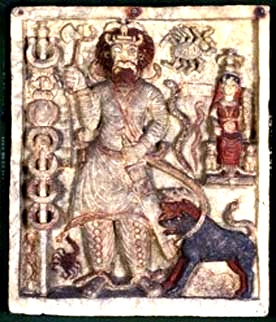
The name Nergal (or Nirgal, Nirgali) refers to a deity in Babylonia with the main seat of his cult at Cuthah (or Kutha) represented by the mound of Tell-Ibrahim. Nergal is mentioned in the Hebrew bible as the deity of the city of Cuth (Cuthah): "And the men of Babylon made Succoth-benoth, and the men of Cuth made Nergal" (2 Kings, 17:30).
Nergal actually seems to be in part a solar deity, sometimes identified with Shamash, but a representative of a certain phase only of the sun. Portrayed in hymns and myths as a god of war and pestilence, Nergal seems to represent the sun of noontime and of the summer solstice which brings destruction to mankind, high summer being the dead season in the Mesopotamian annual cycle.
Nergal was also the deity who presides over the nether-world, and who stands at the head of the special pantheon assigned to the government of the dead (supposed to be gathered in a large subterranean cave known as Aralu or Irkalla). In this capacity he has associated with him a goddess Allatu or Ereshkigal, though at one time Allatu may have functioned as the sole mistress of Aralu, ruling in her own person. In some texts the god Ninazu is the son of Nergal by Allatu/Ereshkigal.
Ordinarily Nergal pairs with his consort Laz. Standard iconography pictured Nergal as a lion, and boundary-stone monuments symbolise him with a mace surmounted by the head of a lion.
Nergal's fiery aspect appears in names or epithets such as Lugalgira, Sharrapu ("the burner," perhaps a mere epithet), Erra, Gibil (though this name more properly belongs to Nusku), and Sibitti. A certain confusion exists in cuneiform literature between Ninurta and Nergal. Nergal has epithets such as the "raging king," the "furious one," and the like. A play upon his name separated into three elements as Ne-uru-gal (lord of the great dwelling) expresses his position at the head of the nether-world pantheon.
In the astral-theological system Nergal becomes the planet Mars, while in ecclesiastical art the great lion-headed colossi serving as guardians to the temples and palaces seem to symbolise Nergal, just as the bull-headed colossi probably typify Ninurta.
Nergal's chief temple at Cuthah bore the name Meslam, from which the god receives the designation of Meslamtaeda or Meslamtaea, "the one that rises up from Meslam". The name Meslamtaeda/Meslamtaea indeed is found as early as the list of gods from Fara while the name Nergal only begins to appear in the Akkadian period.
The cult of Nergal does not appear to have spread as widely as that of Ninurta. Hymns and votive and other inscriptions of Babylonian and Assyrian rulers frequently invoke him, but we do not learn of many temples to him outside of Cuthah. Sennacherib speaks of one at Tarbisu to the north of Nineveh, but significantly, although Nebuchadnezzar II (606 BC586 BC), the great temple-builder of the neo-Babylonian monarchy, alludes to his operations at Meslam in Cuthah, he makes no mention of a sanctuary to Nergal in Babylon. Local associations with his original seat Kutha and the conception formed of him as a god of the dead acted in making him feared rather than actively worshipped.
Text adapted from the 1911 Encyclopædia Britannica.
SHAMASH SAMA - AHAMASH - UTU
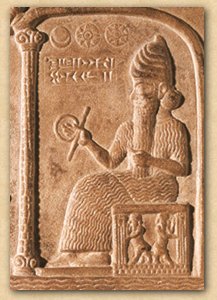
Shamash or Sama, was the common Akkadian name of the sun-god in Babylonia and Assyria, corresponding to Sumerian Utu.
The name signifies perhaps "servitor," and would thus point to a secondary position occupied at one time by this deity. Both in early and in late inscriptions Sha-mash is designated as the "offspring of Nannar," i.e. of the moon-god, and since, in an enumeration of the pantheon, Sin generally takes precedence of Shamash, it is in relationship, presumably, to the moon-god that the sun-god appears as the dependent power.
Such a supposition would accord with the prominence acquired by the moon in the calendar and in astrological calculations, as well as with the fact that the moon-cult belongs to the nomadic and therefore earlier, stage of civilization, whereas the sun-god rises to full importance only after the agricultural stage has been reached.
The two chief centres of sun-worship in Babylonia were Sippar, represented by the mounds at Abu Habba, and Larsa, represented by the modern Senkerah. At both places the chief sanctuary bore the name E-barra (or E-babbara) "the shining house" a direct allusion to the brilliancy of the sun-god. Of the two temples, that at Sippara was the more famous, but temples to Shamash were erected in all large centres such as Babylon, Ur, Mari, Nippur and Nineveh.
The attribute most commonly associated with Shamash is justice. Just as the sun disperses darkness, so Shamash brings wrong and injustice to light. Hammurabi attributes to Shamash the inspiration that led him to gather the existing laws and legal procedures into a code, and in the design accompanying the code the king represents himself in an attitude of adoration before Shamash as the embodiment of the idea of justice.
Several centuries before Hammurabi, Ur-Engur of the Ur dynasty (c. 2600 BC) declared that he rendered decisions "according to the just laws of Shamash."
It was a logical consequence of this conception of the sun-god that he was regarded also as the one who released the sufferer from the grasp of the demons. The sick man, therefore, appeals to Shamash as the god who can be depended upon to help those who are suffering unjustly. This aspect of the sun-god is vividly brought out in the hymns addressed to him, which are, therefore, among the finest productions in the entire realm of Babylonian literature.
It is evident from the material at our disposal that the Shamash cults at Sippar and Larsa so overshadowed local sun-deities elsewhere as to lead to an absorption of the minor deities by the predominating one. In the systematized pantheon these minor sun-gods become attendants that do his service. Such are Bunene, spoken of as his chariot driver, whose consort is Atgi-makh, Kettu ("justice") and Mesharu ("right"), who are introduced as servitors of Shamash.
Other sun-deities, as Ninurta and Nergal, the patron deities of important centres, retained their independent existence as certain phases of the sun, Ninib becoming the sun-god of the morning and of the spring time, and Nergal the sun-god of the noon and of the summer solstice, while Shamash was viewed as the sun-god in general.
Together with Sin and Ishtar, Shamash forms a second triad by the side of Anu, Enlil and Ea. The three powers, Sin, Shamash and Ishtar, symbolized the three great forces of nature, the sun, the moon and the life-giving force of the earth.
At times, instead of Ishtar, we find Adad, the storm-god, associated with Sin and Shamash, and it may be that these two sets of triads represent the doctrines of two different schools of theological thought in Babylonia which were subsequently harmonized by the recognition of a group consisting of all four deities.
The consort of Shamash was known as A. She, however, is rarely mentioned in the inscriptions except in combination with Shamash.
SIN - NANNA
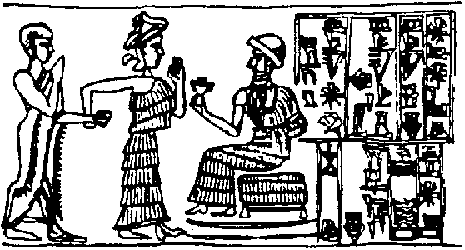
Nanna is a god in Sumerian mythology, god of the moon, son of Enlil and Ninlil. His sacred city was Ur. The name Nanna is Sumerian for "illuminater".
He was named Sin in Babylonia and Assyrian and was also worshipped by them in Harran. Sin had a beard made of lapis lazuli and he rode on a winged bull.
His wife was Ningal ('Great Lady') who bore him Utu 'Sun' and Inana and in some texts Ishkur.
His symbols are the crescent moon, the bull, and a tripod (which may be a lamp-stand).The two chief seats of Sin's worship were Ur in the south, and Harran to the north. The cult of Sin spread to other centres, at an early period, and temples to the moon-god are found in all the large cities of Babylonia and Assyria.
He is commonly designated as En-zu = "lord of wisdom". This attribute clings to him through all periods. During the period (c. 2600-2400 BC) that Ur exercised a large measure of supremacy over the Euphrates valley, Sin was naturally regarded as the head of the pantheon. It is to this period that we must trace such designations of Sin as "father of the gods", "chief of the gods", "creator of all things", and the like. We are justified in supposing that the cult of the moon-god was brought into Babylonia by Semitic nomads from Arabia.
The moon-god is par excellence the god of nomadic peoples. The moon being their guide and protector at night when, during a great part of the year, they undertake their wanderings. This is just as the sun-god is the chief god of an agricultural people. The cult once introduced would tend to persevere, and the development of astrological science culminating in a calendar and in a system of interpretation of the movements and occurrences in the starry heavens would be an important factor in maintaining the position of Sin in the pantheon.
Sin's chief sanctuary at Ur was named E-gish-shir-gal = "house of the great light". His sanctuary at Harran was named E-khul-khul = "house of joys". On seal-cylinders he is represented as an old man with flowing beard with the crescent as his symbol. In the astral-theological system he is represented by the number 30, and the planet Venus and his daughter by the number 15. This 30 probably refers to the average number of days (correctly around 29.53) in a lunar month as measured between successive new moons.
The "wisdom" personified by the moon-god is likewise an expression of the science of astrology in which the observation of the moon's phases is so important a factor. The tendency to centralize the powers of the universe leads to the establishment of the doctrine of a triad consisting of Sin, Shamash and Ishtar, personifying the moon and the sun and the earth as the life-force.
TIAMAT - LEVIATHAN
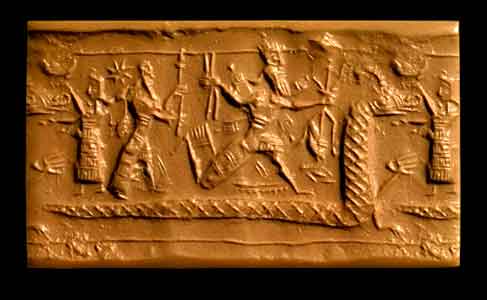
THIS IS THE BATTLE OF TIAMAT AND MARDUK
Tiamat is a primeval monster/goddess in Babylonian and Sumerian mythology, and a central figure in the Enûma Elish creation epic. John C. L. Gibson, in the Ugaritic glossary of Canaanite Myths and Legends, notes that "tehom" appears in the Ugaritic texts, c. 14001200 BCE, simply meaning the "sea". Such a depersonalized Tiamat (the -at ending makes her feminine) is "The Deep" (Hebrew tehom), present at the beginning of the book of Genesis.
Apsu (or Abzu) fathered upon Tiamat the Elder gods Lahmu and Lahamu, the grandparents of Anu and Ea. Lahmu and Lahamu, in turn, were the parents of the heavens (Anshar) and the earth (Kishar). Tiamat was the "shining" goddess of salt water who roared and smote in the chaos of original creation. She and Apsu filled the cosmic abyss with the primeval waters. She is "Ummu-Hubur who formed all things".
The god Enki (later Ea), believing correctly that Apsu was planning to murder the younger gods, slew him. This angered Tiamat, whereupon she fashioned monsters to battle the gods. These were her own offspring, sea-serpents of terrifying size, storms and fish-men and scorpion-men.
Tiamat had the Tablets of Destiny, and in the primordial battle she gave them to Kingu, the god she had chosen for her lover. But Anu (replaced by Marduk, the son of Ea, in the late version that has survived) overcame Kingu and then her, armed with the winds and a net and an invincible spear.
![]()
![]()
Disclaimer:
Some material presented will contain links, quotes, ideologies, etc., the contents of which should be understood to first, in their whole, reflect the views or opinions of their editors, and second, are used in my personal research as "fair use" sources only, and not espousement one way or the other. Researching for 'truth' leads one all over the place...a piece here, a piece there. As a researcher, I hunt, gather and disassemble resources, trying to put all the pieces into a coherent and logical whole. I encourage you to do the same. And please remember, these pages are only my effort to collect all the pieces I can find and see if they properly fit into the 'reality aggregate'.
Personal Position:
I've come to realize that 'truth' boils down to what we 'believe' the facts we've gathered point to. We only 'know' what we've 'experienced' firsthand. Everything else - what we read, what we watch, what we hear - is what someone else's gathered facts point to and 'they' 'believe' is 'truth', so that 'truth' seems to change in direct proportion to newly gathered facts divided by applied plausibility. Though I believe there is 'truth', until someone representing the celestial realm visibly appears and presents the heavenly records of Facts And Lies In The Order They Happened, I can't know for sure exactly what "the whole truth' on any given subject is, and what applies to me applies to everyone. Until then I'll continue to ask, "what does The Urantia Book say on the subject?"
~Gail Bird Allen
![]()
![]()














-
Urantia Book, 44:0.11 - The Celestial Artisans
Never in your long ascendancy will you lose the power to recognize your associates of former existences. Always, as you ascend inward in the scale of life, will you retain the ability to recognize and fraternize with the fellow beings of your previous and lower levels of experience. Each new translation or resurrection will add one more group of spirit beings to your vision range without in the least depriving you of the ability to recognize your friends and fellows of former estates.
-
Princess Bride 1987 Wallace Shawn (Vizzini) and Mandy Patinkin (Inigo Montoya)
Vizzini: HE DIDN'T FALL? INCONCEIVABLE.
Inigo Montoya: You keep using that word. I do not think it means what you think it means. -
Urantia Book, 117:4.14 - The Finite God
And here is mystery: The more closely man approaches God through love, the greater the reality -- actuality -- of that man. The more man withdraws from God, the more nearly he approaches nonreality -- cessation of existence. When man consecrates his will to the doing of the Father's will, when man gives God all that he has, then does God make that man more than he is.
-
Urantia Book, 167:7.4 - The Talk About Angels
"And do you not remember that I said to you once before that, if you had your spiritual eyes anointed, you would then see the heavens opened and behold the angels of God ascending and descending? It is by the ministry of the angels that one world may be kept in touch with other worlds, for have I not repeatedly told you that I have other sheep not of this fold?"
-
Urantia Book, Foreword - 0:12.12 - The Trinities
But we know that there dwells within the human mind a fragment of God, and that there sojourns with the human soul the Spirit of Truth; and we further know that these spirit forces conspire to enable material man to grasp the reality of spiritual values and to comprehend the philosophy of universe meanings. But even more certainly we know that these spirits of the Divine Presence are able to assist man in the spiritual appropriation of all truth contributory to the enhancement of the ever-progressing reality of personal religious experience—God-consciousness.
-
Urantia Book, 1:4.3 - The Mystery Of God
When you are through down here, when your course has been run in temporary form on earth, when your trial trip in the flesh is finished, when the dust that composes the mortal tabernacle "returns to the earth whence it came"; then, it is revealed, the indwelling "Spirit shall return to God who gave it." There sojourns within each moral being of this planet a fragment of God, a part and parcel of divinity. It is not yet yours by right of possession, but it is designedly intended to be one with you if you survive the mortal existence.
-
Urantia Book, 1:4.1 - The Mystery Of God
And the greatest of all the unfathomable mysteries of God is the phenomenon of the divine indwelling of mortal minds. The manner in which the Universal Father sojourns with the creatures of time is the most profound of all universe mysteries; the divine presence in the mind of man is the mystery of mysteries.
-
Urantia Book, 1:4.6 - The Mystery Of God
To every spirit being and to every mortal creature in every sphere and on every world of the universe of universes, the Universal Father reveals all of his gracious and divine self that can be discerned or comprehended by such spirit beings and by such mortal creatures. God is no respecter of persons, either spiritual or material. The divine presence which any child of the universe enjoys at any given moment is limited only by the capacity of such a creature to receive and to discern the spirit actualities of the supermaterial world.
-
Urantia Book, 11:0.1 - The Eternal Isle Of Paradise
Paradise is the eternal center of the universe of universes and the abiding place of the Universal Father, the Eternal Son, the Infinite Spirit, and their divine co-ordinates and associates. This central Isle is the most gigantic organized body of cosmic reality in all the master universe. Paradise is a material sphere as well as a spiritual abode. All of the intelligent creation of the Universal Father is domiciled on material abodes; hence must the absolute controlling center also be material, literal. And again it should be reiterated that spirit things and spiritual beings are real.
-
Urantia Book, 50:6.4 - Planetary Culture
Culture presupposes quality of mind; culture cannot be enhanced unless mind is elevated. Superior intellect will seek a noble culture and find some way to attain such a goal. Inferior minds will spurn the highest culture even when presented to them ready-made.
-
Urantia Book, 54:1.6 - True And False Liberty
True liberty is the associate of genuine self-respect; false liberty is the consort of self-admiration. True liberty is the fruit of self-control; false liberty, the assumption of self-assertion. Self-control leads to altruistic service; self-admiration tends towards the exploitation of others for the selfish aggrandizement of such a mistaken individual as is willing to sacrifice righteous attainment for the sake of possessing unjust power over his fellow beings.
-
Urantia Book, 54:1.9 - True And False Liberty
How dare the self-willed creature encroach upon the rights of his fellows in the name of personal liberty when the Supreme Rulers of the universe stand back in merciful respect for these prerogatives of will and potentials of personality! No being, in the exercise of his supposed personal liberty, has a right to deprive any other being of those privileges of existence conferred by the Creators and duly respected by all their loyal associates, subordinates, and subjects.
-
Urantia Book, 54:1.8 - True And False Liberty
There is no error greater than that species of self-deception which leads intelligent beings to crave the exercise of power over other beings for the purpose of depriving these persons of their natural liberties. The golden rule of human fairness cries out against all such fraud, unfairness, selfishness, and unrighteousness.

